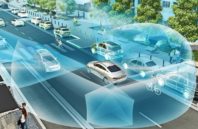Autonomous cars are hot—a multi-billion-dollar business opportunity that could transform mobility. Beyond everyday use, self-driving cars could expand transportation options for the elderly and disabled and ease business travel by guiding drivers in unfamiliar locales. Perhaps most important, their use could reduce the deadly toll of traffic accidents by removing a primary cause: the proverbial “nut behind the wheel” who is prone to speeding, drinking or texting-while-driving.
Achieving automotive autonomy requires artificial intelligence to process and integrate data from a suite of sensors including cameras, microwave radar, ultrasonic sensors and laser radar, better known as lidar. Each sensor in the suite has its strengths and weaknesses. Ultrasonics are good at sensing nearby objects for parking, but too short-ranged for driving. Cameras show the local environment, but don’t measure distance. Microwave radar measures distance and speed, but has limited resolution. Lidar pinpoints distance and builds up a point cloud of the local environment, but at present it has a limited range and a steep price tag. Extending lidar’s range, and reducing its costs, thus forms a key challenge for making autonomous driving an everyday reality.

 (585) 768-2513
(585) 768-2513

